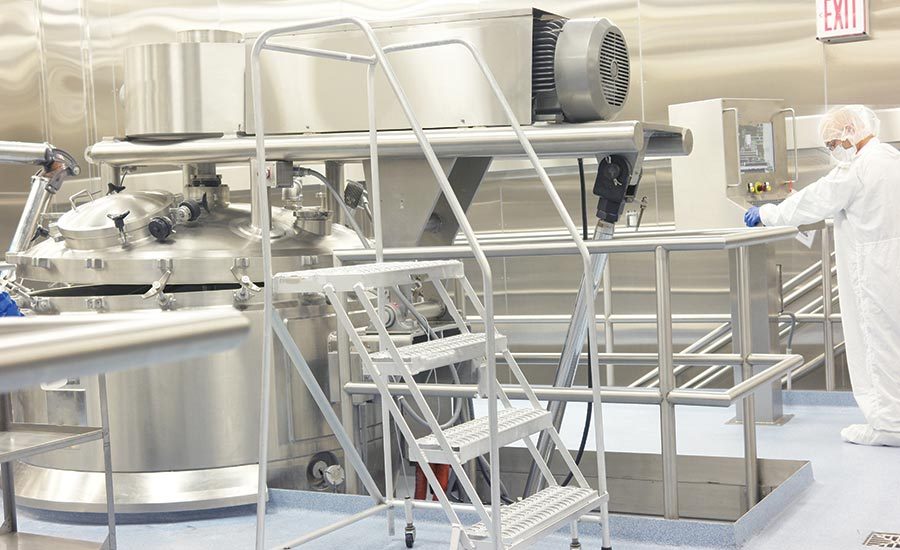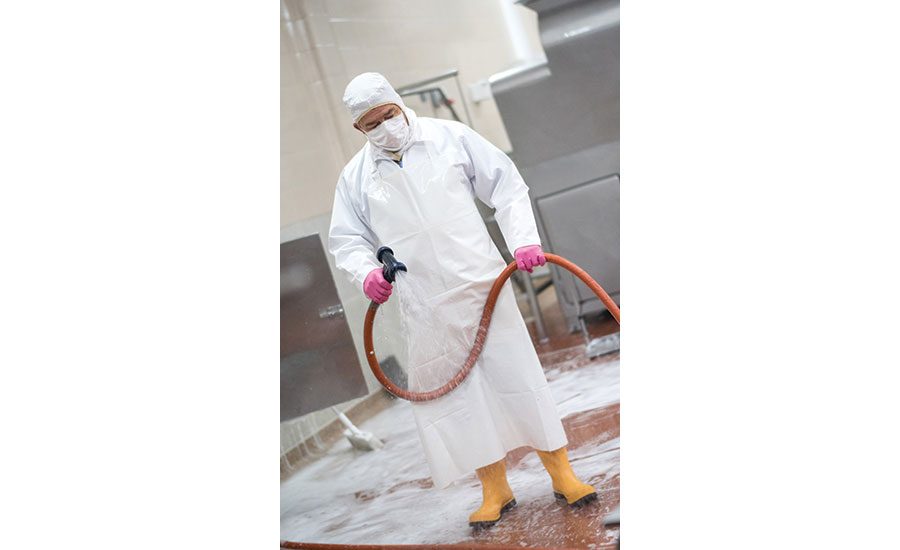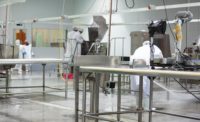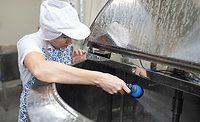A cleaning and sanitizing process is one of the most important prerequisite programs in the food processor’s tool box. It has always been a key element for ensuring food safety and quality, but its importance has escalated over the years.
Today, the Preventive Controls for Human Food regulation found in 21 CFR Part 117 specifically acknowledges sanitation preventive controls among the basic preventive controls for ensuring food safety. Take a look at the following quotes and keep them in mind as we talk about what a good sanitation program should include:
- “Sanitation maintains or restores a state of cleanliness and promotes hygiene for prevention of foodborne illness.”
—Appendix A Meat HACCP Regulation - “It has not yet succeeded in developing a culture throughout the seafood industry in which processors assume an operative role in controlling sanitation in their plants.”
—Preamble to Seafood HACCP Regulation - “Sanitation, especially those issues related to cleaning and sanitizing and routine maintenance aimed at assuring safe operation of equipment, should now be included in the prerequisite program and not be considered to be CCPs.”
—Preamble to Seafood HACCP Regulation - “Pest control is 90 percent good sanitation.”
—Jim Bowyer, Clark Pest Control - “You can’t sanitize a dirty surface.”
—Neil Bogart, Ecolab
The goal of cleaning and sanitizing has been expanded. Soil removal also includes allergens to ensure that no cross-contact happens between different products that contain allergens.
A comprehensive cleaning and sanitation program has to consider all of the factors, not just cost, says Neil Bogart, executive area technical coordinator, Ecolab.
“It is easy to come in and sell a low-cost program,” says Bogart. “But will it be effective? Usually not. Will the chemistry work with the water quality? What is the condition of the CIP system, the equipment (SS or soft metal), the building? What are the types of soils and load? Is the equipment even designed to be cleaned? Do they PM the CIP system or not? Typically in my experience, the CIP skid is the most forgotten piece of equipment in any manufacturing facility. It is almost always ‘run to fail.’”
With that in mind, processors have to take a comprehensive view when designing a cleaning and sanitation program.
Critical elements of good sanitation
A food processor’s cleaning and sanitation program encompasses many different elements. The most obvious is the actual cleaning and sanitizing of equipment. Other elements include:
- Waste management
- Master cleaning schedule
- Routine cleaning (spills)
- Sanitary design
- Specialty cleaning equipment
Let’s touch on these elements first.
Waste management: Disposing of waste, which includes organic waste from production, is essential to ensuring plant cleanliness. Processors recycle cardboard, dispose of inedible waste, make efforts to utilize food waste, and address wastewater from production, cleaning and other in-house applications. Most processors have adopted color-coding programs of some sort to segregate waste from the plant and production operations. The different waste streams are transferred from the color-coded collection areas to dumpsters or other areas (recycling stations) for removal from the grounds.
One challenge for processors is the newly enacted Preventive Controls for Animal Food and Feed regulation. What was once collected and picked up as a feed source by local cattle or hog farmers may need to processed in some way or may not be allowed to be diverted to feed any longer.
Master cleaning schedule: Food processors need to develop a master cleaning schedule. This document or register must include all equipment in the plant, walls, floors, drains, overhead structures, lighting, loading docks, warehouse facilities, lockers, utensils, totes, baskets and anything else in the facility that needs to be cleaned. And it must include how frequently each item must be cleaned. Processing equipment will be cleaned daily or maybe even each shift, whereas overheads might be cleaned every quarter.
When establishing cleaning schedules, consider factors including the type of products being manufactured, the design and age of the building, and production scheduling. As an example, a processor that utilizes grains, flour or other items with dust might schedule cleaning of overheads more frequently than an operator producing frozen vegetables. Ideally, the HACCP or food safety team should review cleaning schedules and establish frequencies based on risk, an assessment that should be documented. This can be an imposing document. And it is up to the sanitation manager to ensure that the scheduled cleaning frequencies are followed.
Routine cleaning: Cleaning is an ongoing exercise in a food processing facility. It must include programs to clean any spills or leaks as promptly as possible. This is especially true in warehouse operations where allergens are handled. The goal is to get spills taken care of as quickly as possible.
Conducting routine cleaning during production also is good practice. Workers should be assigned to continuously remove product that falls from belts or lines, which eliminates a slipping hazard and makes cleaning easier at the end of the shift or day. Removal of materials should be done with squeegees. Mops are a potential contamination risk, and water must be used with great care during production to minimize potential cross-contamination.
Sanitary design: Proper sanitary equipment design will enhance the cleaning efficiencies. The harder it is to clean a piece of equipment, the less likely that the cleanup will be done properly. As an example, if the crew has to remove six bolts to access the interior of a machine to clean it, there is a chance that the work might not be done or might not be done right. However, if those six bolts were replaced with quick-release snaps, the unit would be much easier to clean.
Sanitary design is acknowledged as an essential element for ensuring the production of safe and quality foods. The American Meat Institute’s (AMI) Equipment Design Task Force developed 10 criteria for sanitary equipment design in 2003:
- Cleanable to a microbiological level
- Made of compatible materials
- Accessible for inspection, maintenance, cleaning and sanitation
- No product or liquid collection
- Hollow areas hermetically sealed
- No niches
- Sanitary operational performance
- Hygienic design of maintenance enclosures
- Hygienic compatibility with other plant systems
- Validate cleaning and sanitizing protocols
These equipment standards will help ensure more efficient cleaning. The first principle, cleanable to a microbiological level, sets the stage. We will look into the final point, validation of cleaning and sanitizing, later on.
Joe Stout, who served on the AMI equipment design committee, is now vice chair of the GFSI Technical Working Group on Hygienic Design, and he runs Commercial Food Sanitation LLC.
“Hygienic design is the most important improvement opportunity to help reduce harborage points, improve access for cleaning, reduce the time needed to do effective planning and improve food safety,” he says.
Specialty cleaning equipment: Many processors will buy or build specialty cleaning equipment. This may be clean-out-of-place (COP) tanks, dishwashers for utensils, or washers for baskets or totes. One advantage of COP systems is that they are designed to both clean and sanitize items. The industrial dishwashers that a processor might use to clean knives, spoons, scoops or other utensils will wash the dishes in hot water with detergent and utilize hot water as a sanitizing rinse. They also include a drying cycle, so utensils may be removed and stored immediately.
Basket or tote washers are products that any processor utilizing bins or baskets should consider. These systems employ several cycles to rinse gross soil, wash baskets with soap and hot water, rinse, and possibly apply sanitizer. The units are designed to be energy and water efficient. Wash baskets or totes should be stored to minimize contamination on racks or pallets off the ground. The washers are much more effective than turning someone loose with a high-pressure water hose in a confined area. Douglas Machines, AEC Systems and Newsmiths are among companies that build and market such systems.
Cleaning and sanitizing
Developing, documenting and implementing good cleaning and sanitizing procedures are what the program is all about. Part of implementation is ensuring that the persons assigned to cleanup are well-trained on the procedures and understand the tasks’ importance. The type of cleaning that is done depends upon the products being manufactured. With most food products, wet cleaning processes are employed, but there are foods that can use dry cleaning procedures. That will be the subject of another article. Cleaning and sanitizing are two distinct operations. These two terms are defined as:
Cleaning: Removal of soil particles from surfaces by mechanical, manual or chemical methods
Sanitizing: Treatment of a cleaned surface with a chemical or physical agent to destroy disease/spoilage-causing organisms. Reduces total vegetative cell population to a safe level
We see Bogart’s comment—“You can’t sanitize a dirty surface”—reiterated in the definition of sanitizing: the treatment of a cleaned surface.
There are five basic steps in wet cleaning and sanitizing that hold true for almost all types of soil and food processing systems. They are:
- Flush or sweep the excess soil from the surface with water of an appropriate temperature. When sweeping gross soil from floors, squeegees are the preferred tool since they are easier to clean themselves. Brooms, mops or brushes are not recommended in wet cleaning operations. Bogart emphasizes that gross soil removal by flushing is perhaps the most important step, as cleaning compounds are simply not designed to remove it. In addition, using such materials before flushing the surface wastes money.
- Use the appropriate cleaner and method for the surface. Scrubbing to remove stubborn soils also may be necessary.
- Flush the cleaner from the surface with water at an appropriate temperature.
- Apply the appropriate sanitizer.
- Rinse the sanitizer from the surface with clean water, if not using no-rinse sanitizers.
Many also utilize a seven-step sanitation program that incorporates inspection steps.
Now let’s look at sanitizers, assuming that surfaces have been cleaned properly.
When most people think of sanitizers, they think only of chemicals. But one of the best sanitizers is heat, especially hot water or steam. Heating and holding surfaces to 180˚F or above for five minutes using wet heat will effectively sanitize that surface. When using steam in enclosed systems, the recommendation is 200˚F, assuming the outlet temperature for the steam is at that temperature. Many CIP and COP systems utilize hot water to sanitize after the wash step. COP tanks first circulate soapy water and then after a rinse will sanitize the utensils, pipes or equipment for five to ten minutes in hot water in excess of 180˚F. In closed systems using CIP, hot water or hot water that has been acidified with citric acid may be used as a sanitizer.
There are a wide range of sanitizers available on the market. The one used depends on products, objectives and cost. When selecting a sanitizer, consider factors including:
- Temperature
- Soil load
- pH
- Water hardness
- Type of surface
- Foam level
- Residual activity
As an example, chlorine is inexpensive but reacts rapidly with organic matter and loses activity. It is also affected by pH. Chlorine activity is a function of the presence of the hypochlorous acid. Water with an elevated pH (8.0 or above) will have a very low level of hypochlorous acid.
Quaternary ammonia compounds are a common choice for environmental sanitizer because of their residual activity. They are very effective against gram-positive bacteria, but not so with gram negatives. Many companies using quats will utilize another sanitizer on a weekly basis to ensure that bacteria in the plant do not become acclimated to the quats.
“If a sanitizer that has been effective and used for a long time becomes ineffective, then something has failed in the cleaning part of the C&S program,” says Bogart.
In many food plant operations, the sanitation crew will wrap cleaning by applying a no-rinse sanitizer. This provides residual disinfecting activity and will remain on the surface until production is initiated.
Verification of results
Maintenance of sanitation programs is essential for ensuring safe and quality foods. This means that processors follow to the letter the cleaning programs day after day. And the proof is in the documentation. There should be several levels of documentation that show, “We did the cleaning properly.”
The first would be the cleaning record done right after the work was completed. Each and every piece of equipment should be listed for inspection, with a notation that it was cleaned properly. Persons doing these inspections and the pre-operational inspections should be trained on what to look for and should have flashlights to better observe if cleaning was done properly. This document should also include spaces to record cleaner and sanitizer strengths and temperatures employed.
Most companies will set up their forms with four columns: satisfactory, unsatisfactory, comments and initials or signature. Operators should consider increasing the number of columns to force the reviewer to evaluate the quality of the work. Some use a form with five evaluation columns: excellent, good, fair, below average and poor. The cleaning must be rated good or above for the crew to go home.
Many companies incorporate a hygiene monitoring program into their cleanup program. ATP swabs give results in minutes, so it is possible to let the cleanup crew know that something has not been done correctly.
“Every company needs to have and should have a hygiene monitoring system since that is the final part of the puzzle,” says Cliff Coles, president, CMC Food Safety Consulting. “This is where the sanitation, housekeeping efforts and, to some degree, the preventive maintenance programs can be evaluated, upgraded and rationally assessed as to the effectiveness of the programs. In management terms it is simply the ROI. None of the programs are cheap, but if I cannot measure the return to the investment in food safety, then why does the company incur the expense?”
Tying it all together
Putting together a comprehensive and effective cleaning and sanitizing program with the necessary verification programs is “the responsibility of everyone in the company,” Coles says. And maybe others from outside the company should be involved.
Processors should consider bringing in a third party to assist in the development of their sanitation program. The new set of eyes often reveals things that create one of those aha moments.
“The sanitation process is so fundamental and important to food safety that it is critical to observe, evaluate and improve this process with each visit,” says Stout. “Often times we need to remind teams of the simple things that they repeatedly need to do to ensure effective cleaning. It might be something as simple as leaving the foam cleaner on a surface for less time or providing the right amount of mechanical action to loosen soil.”
Jim Whitehead, vice president of sales and marketing, PSSI, says that the company uses outside testing to help ensure that the plans it develops for customers are accomplishing their goals.
“Our team of experts is not only responsible for designing our programs to ensure a high level of performance, but they are highly engaged with our customers on troubleshooting, existing issues with operational sanitation and leveraging new technology for pathogen control,” says Whitehead. “Most of the testing is done onsite by outside laboratories. But we collaborate on protocols and the evaluation of the results.”
The key words for a good sanitation program are develop, document, implement and maintain. Implementation must include training that is documented, and maintenance must include good recordkeeping and verification programs that ensure the program stays on track and people continue to do what is defined in the documentation.
In other words: Do what you say and say what you do.
For more information:
Neil Bogart, Ecolab, www.ecolab.com
Joe Stout, Commercial Food Sanitation LLC, joestout@cf-san.com
Cliff Coles, CMC Food Safety Consulting, cmlkcoles@gmail.com
Jim Whitehead, PSSI, www.pssi.com






